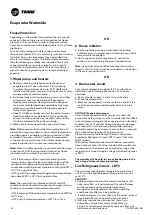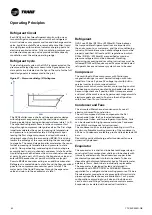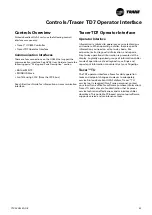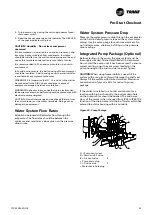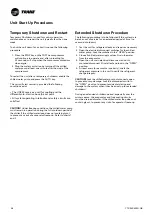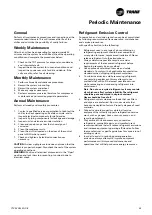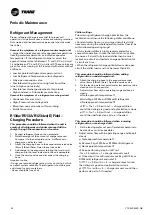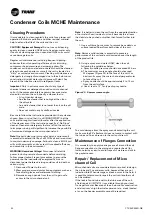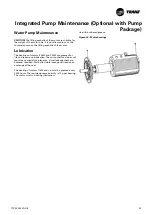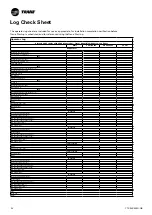
CTV-SVX009D-GB
49
11
UNT-PRC002-GB
Sound power levels
Discharge
Measurement conditions:
Measurements taken in a room adjacent to the room containing the FWD, at the outlet of the rectangular duct (1.5 m
long) fixed to its discharge opening.
Fan
Power level in dB(A), per Hz frequency band
Overall power
Unit
speed
125
250
500
1000
2000
4000
8000
dB(A)
1
55
50
42
37
37
31
30
46
FWD 08
2
57
54
47
40
30
38
40
50
3
58
57
50
42
32
40
43
53
1
57
51
45
42
34
33
28
48
FWD 10
2
58
54
48
45
38
39
35
51
3
60
58
50
48
40
42
39
54
1
57
51
45
42
34
33
28
48
FWD 12
2
58
54
48
45
38
39
35
51
3
60
58
50
48
40
42
39
54
1
56
62
50
48
39
38
36
56
FWD 14
2
61
66
55
53
47
46
45
60
3
63
69
58
56
50
50
49
63
1
57
63
51
49
40
39
37
57
FWD 20
2
61
66
55
53
47
46
45
60
3
63
69
58
56
50
50
49
63
Intake
Measurement conditions:
Measurements taken at the horizontal air intake.
Fan
Power level in dB(A), per Hz frequency band
Overall power
Unit
speed
125
250
500
1000
2000
4000
8000
dB(A)
1
56
55
55
53
46
45
42
57
FWD 08
2
63
62
60
60
53
53
53
64
3
66
65
63
62
56
55
57
67
1
62
58
55
58
51
48
44
61
FWD 10
2
66
63
60
62
56
55
52
66
3
70
67
63
65
59
59
57
69
1
62
58
55
58
51
48
44
61
FWD 12
2
66
63
60
62
56
55
52
66
3
70
67
63
65
59
59
57
69
1
66
65
65
65
57
50
46
68
FWD 14
2
73
72
69
71
64
59
57
74
3
78
76
73
75
69
64
63
78
1
68
72
64
64
56
52
50
69
FWD 20
2
76
76
68
71
65
61
61
75
3
78
79
71
74
69
66
66
78
Periodic Maintenance
General
Perform all maintenance procedures and inspections at the
recommended intervals. This will increase the life of the
chiller and minimize the possibility of costly failures.
Weekly Maintenance
After the unit has been operating for approximately 30
minutes and the system has stabilized, check the operating
conditions and complete the procedures below:
1. Check on the TD7 pressure for evaporator, condenser,
and intermediate oil.
2. Inspect the entire system for unusual conditions and
inspect the condenser coils for dirt and debris. If the
coils are dirty, refer to coil cleaning.
Monthly Maintenance
1. Perform all weekly maintenance procedures.
2. Record the system subcooling.
3. Record the system superheat.
4. Make any repairs necessary.
5. Review compressor service literature for compressor
maintenance and record appropriate parameters.
Annual Maintenance
Perform all weekly and monthly procedures.
1. Contact a qualified service organization to leak-test the
chiller, to check operating and safety controls, and to
inspect electrical components for deficiencies
2. Inspect all piping components for leakage and damage.
3. Inspect unit and also areas under isolation.
4. Clean and repaint any areas that show signs of
corrosion.
5. Clean the condenser coils.
6. Clean the air filter located on the door of the control
panel of AFD when present
7. Check and tighten all electrical connections as
necessary.
CAUTION!
A clear sight glass alone does not mean that the
system is properly charged. Also check the rest of the system
operating conditions.
WARNING!
Position all electrical disconnects in the “Open”
position and lock them to prevent injury or death due to
electrical shock.
Refrigerant Emission Control
Conservation and emission reduction can be accomplished
by following recommended Trane operation, maintenance,
and service procedures,
with specific attention to the following:
1. Refrigerant used in any type of air-conditioning or
refrigerating equipment should be recovered and/
or recycled for reuse, reprocessed (reclaimed). Never
release refrigerant into the atmosphere.
2. Always determine possible recycle or reclaim
requirements of the recovered refrigerant before
beginning recovery by any method.
3. Use approved containment vessels and safety
standards. Comply with all applicable transportation
standards when shipping refrigerant containers.
4. To minimize emissions while recovering refrigerant,
use recycling equipment. Always attempt to use
methods that will pull the lowest possible vacuum
while recovering and condensing refrigerant into
containment.
Note: Do not use recycled refrigerant as it may contain
oil, which can affect system reliability. The refrigerant
should be pure and stored in virgin containers.
Hoses should be free of oil.
5. Refrigerant-system cleanup methods that use filters
and dryers are preferred. Do not use solvents that
have ozone depletion factors. Properly dispose of used
materials.
6. Take extra care to properly maintain all service
equipment that directly supports refrigeration service
work, such as gauges, hoses, vacuum pumps, and
recycling equipment.
7. Stay aware of unit enhancements, conversion
refrigerants, compatible parts, and manufacturer’s
recommendations that will reduce refrigerant emissions
and increase equipment operating efficiencies. Follow
the manufacturer’s specific guidelines for conversion of
existing system.
8. In order to assist in reducing power-generation
emissions, always attempt to improve equipment
performances with improved maintenance and
operations that will help conserve energy resources.


